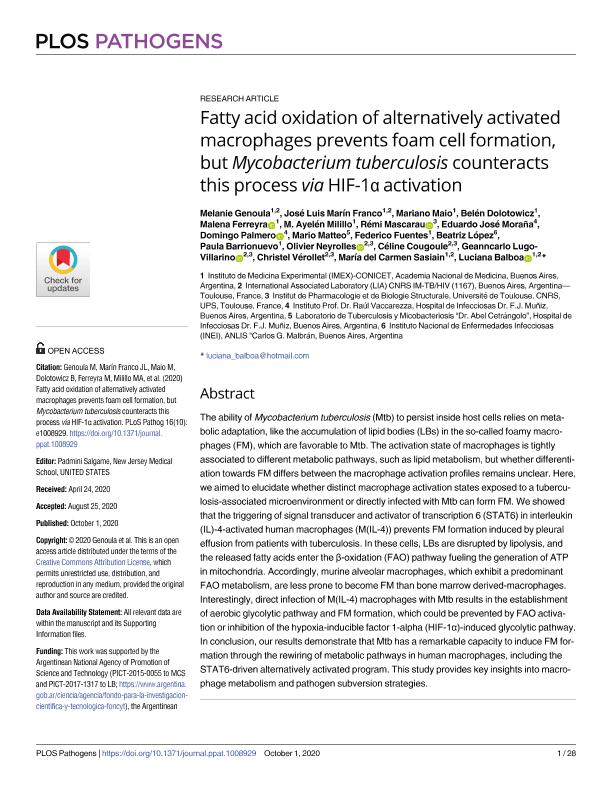Artículo
Fatty acid oxidation of alternatively activated macrophages prevents foam cell formation, but Mycobacterium tuberculosis counteracts this process via HIF-1α activation
Genoula, Melanie ; Marin Franco, Jose Luis
; Marin Franco, Jose Luis ; Maio, Mariano; Dolotowicz, Belén; Ferreyra Compagnucci, Malena María
; Maio, Mariano; Dolotowicz, Belén; Ferreyra Compagnucci, Malena María ; Milillo, María Ayelén
; Milillo, María Ayelén ; Mascarau, Rémi; Moraña, Eduardo José; Palmero, Domingo Juan; Matteo, Mario José; Fuentes, Federico
; Mascarau, Rémi; Moraña, Eduardo José; Palmero, Domingo Juan; Matteo, Mario José; Fuentes, Federico ; López, Beatriz; Barrionuevo, Paula
; López, Beatriz; Barrionuevo, Paula ; Neyrolles, Olivier; Cougoule, Céline; Lugo Villarino, Geanncarlo; Vérollet, Christel; Sasiain, María del Carmen; Balboa, Luciana
; Neyrolles, Olivier; Cougoule, Céline; Lugo Villarino, Geanncarlo; Vérollet, Christel; Sasiain, María del Carmen; Balboa, Luciana
 ; Marin Franco, Jose Luis
; Marin Franco, Jose Luis ; Maio, Mariano; Dolotowicz, Belén; Ferreyra Compagnucci, Malena María
; Maio, Mariano; Dolotowicz, Belén; Ferreyra Compagnucci, Malena María ; Milillo, María Ayelén
; Milillo, María Ayelén ; Mascarau, Rémi; Moraña, Eduardo José; Palmero, Domingo Juan; Matteo, Mario José; Fuentes, Federico
; Mascarau, Rémi; Moraña, Eduardo José; Palmero, Domingo Juan; Matteo, Mario José; Fuentes, Federico ; López, Beatriz; Barrionuevo, Paula
; López, Beatriz; Barrionuevo, Paula ; Neyrolles, Olivier; Cougoule, Céline; Lugo Villarino, Geanncarlo; Vérollet, Christel; Sasiain, María del Carmen; Balboa, Luciana
; Neyrolles, Olivier; Cougoule, Céline; Lugo Villarino, Geanncarlo; Vérollet, Christel; Sasiain, María del Carmen; Balboa, Luciana
Fecha de publicación:
10/2020
Editorial:
Public Library of Science
Revista:
Plos Pathogens
ISSN:
1553-7366
Idioma:
Inglés
Tipo de recurso:
Artículo publicado
Clasificación temática:
Resumen
The ability of Mycobacterium tuberculosis (Mtb) to persist inside host cells relies on metabolic adaptation, like the accumulation of lipid bodies (LBs) in the so-called foamy macrophages (FM), which are favorable to Mtb. The activation state of macrophages is tightly associated to different metabolic pathways, such as lipid metabolism, but whether differentiation towards FM differs between the macrophage activation profiles remains unclear. Here, we aimed to elucidate whether distinct macrophage activation states exposed to a tuberculosis-associated microenvironment or directly infected with Mtb can form FM. We showed that the triggering of signal transducer and activator of transcription 6 (STAT6) in interleukin (IL)-4-activated human macrophages (M(IL-4)) prevents FM formation induced by pleural effusion from patients with tuberculosis. In these cells, LBs are disrupted by lipolysis, and the released fatty acids enter the β-oxidation (FAO) pathway fueling the generation of ATP in mitochondria. Accordingly, murine alveolar macrophages, which exhibit a predominant FAO metabolism, are less prone to become FM than bone marrow derived-macrophages. Interestingly, direct infection of M(IL-4) macrophages with Mtb results in the establishment of aerobic glycolytic pathway and FM formation, which could be prevented by FAO activation or inhibition of the hypoxia-inducible factor 1-alpha (HIF-1α)-induced glycolytic pathway. In conclusion, our results demonstrate that Mtb has a remarkable capacity to induce FM formation through the rewiring of metabolic pathways in human macrophages, including the STAT6-driven alternatively activated program. This study provides key insights into macrophage metabolism and pathogen subversion strategies.
Archivos asociados
Licencia
Identificadores
Colecciones
Articulos(IMEX)
Articulos de INST.DE MEDICINA EXPERIMENTAL
Articulos de INST.DE MEDICINA EXPERIMENTAL
Citación
Genoula, Melanie; Marin Franco, Jose Luis; Maio, Mariano; Dolotowicz, Belén; Ferreyra Compagnucci, Malena María; et al.; Fatty acid oxidation of alternatively activated macrophages prevents foam cell formation, but Mycobacterium tuberculosis counteracts this process via HIF-1α activation; Public Library of Science; Plos Pathogens; 16; 10; 10-2020; 1-28
Compartir
Altmétricas



